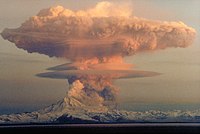
Photo from wikipedia
K-Ar dating of illite (clay) in weathered bedrock (saprolite) is an exciting but yet incompletely understood new application of the K-Ar dating method that can potentially provide valuable information about… Click to show full abstract
K-Ar dating of illite (clay) in weathered bedrock (saprolite) is an exciting but yet incompletely understood new application of the K-Ar dating method that can potentially provide valuable information about the evolution of landforms and continental isostasy. Fredin et al.1 use this approach in an attempt to date the strandflat in coastal western Scandinavia. Based on K-Ar illite ages from three widely separated localities in the North Sea (Utsira High), West Norway (Bømlo), and southern Sweden (Ivö), they suggest a Late Triassic (~210Ma) age for the strandflat. However, when employing such a new methodology, it is particularly important to carefully consider the results together with existing data, and Fredin et al.1 neglect previously published radiometric, stratigraphic, and geomorphic constraints that strongly suggest that the current strandflat erosional level in western Norway is younger than Triassic. The discovery of Late Jurassic (Oxfordian) sediment caught up in a fault zone in Proterozoic bedrock near Bergen north of Bømlo (Fig. 1) revealed that rocks in the strandflat area were at or near the surface at ~160Ma2, opening the possibility that the strandflat may contain Mesozoic elements3. Offshore, the crystalline bedrock surface is seen as a remarkably planar geomorphic feature on seismic data, preserved under Jurassic sediments (offshore part of Fig. 1b). However, this surface is dipping to the west by ~5°, while the strandflat is almost horizontal (onshore part of Fig. 1b; also shown in Fig. 6 in Fredin et al.1), clearly cutting into the Middle Jurassic paleosurface and thus mainly shaped by younger (post-Middle Jurassic) processes. From geometric considerations, it is therefore quite unlikely that the samples from the Utsira High and Bømlo represent the same weathering surface. Fredin et al.1 claim to be able to constrain the age of the strandflat along the west coast of Norway by dating illite in weathered bedrock. However, K-Ar dating of illite to constrain weathering ages is previously untested; all previous studies cited by Fredin et al.1 use K-bearing manganese oxides or alunitegroup sulfates. Hence, such K-Ar illite weathering ages should be interpreted with care and in the framework of independent data, which in this case include low-temperature thermochronology (fission track and (U–Th)/He ages), the offshore stratigraphic record, structural aspects, and the estimated depth of dike intrusions, as briefly summarized below. A significant quantity of fission track and (U–Th)/He data has recently been published from the strandflat area4. Such ages date the cooling of the currently exposed rocks through the partial annealing/retention zone of the respective system, which is 210–140 °C for the zircon (U–Th)/He system, 120–60 °C for the apatite fission track (AFT) system and 70–40 °C for the apatite (U–Th)/He system. All such ages should be older than the age of any preserved in situ weathering products. A regional compilation of AFT ages from Scandinavia5 shows that AFT ages from the entire Norwegian strandflat area are similar to or, more commonly, younger than the ~210Ma illite ages reported by Fredin et al1. Most ages from the strandflat region relatively near their Bømlo locality show early to middle Jurassic (200–160Ma) AFT ages4 (Fig. 1a). These ages roughly indicate that the samples were buried at >2 km depth in the Early Jurassic, assuming a thermal gradient of 30 °C/km. (U–Th)/He zircon data from the same area of ~225Ma4 suggest burial of the present strandflat level to >4 km depth in the Late Triassic. These data are consistent with paleomagnetic analysis of Permian (~250Ma) dikes in the strandflat area north of Bømlo, which suggests that the dikes were emplaced at ambient temperatures between 150–500 °C (5–15 km depth)6. In slowly cooled basement terranes like western Norway, it can be misleading to reconstruct the exhumation history based on fission track ages alone. More precise and detailed cooling paths can be derived from inverse time–temperature modeling. The resulting models, presented by Ksienzyk et al.4, consistently show cooling throughout the Triassic and into the Jurassic, with postJurassic burial and new exhumation for coastal samples (Fig. 2, blue curves). In order to test for potential Late Triassic weathering, we remodeled strandflat samples by imposing constraints to bring them to the surface in the Late Triassic (green box in Fig. 2). With this constraint, most models showed a significantly DOI: 10.1038/s41467-017-01457-9 OPEN
Journal Title: Nature Communications
Year Published: 2017
Link to full text (if available)
Share on Social Media: Sign Up to like & get
recommendations!